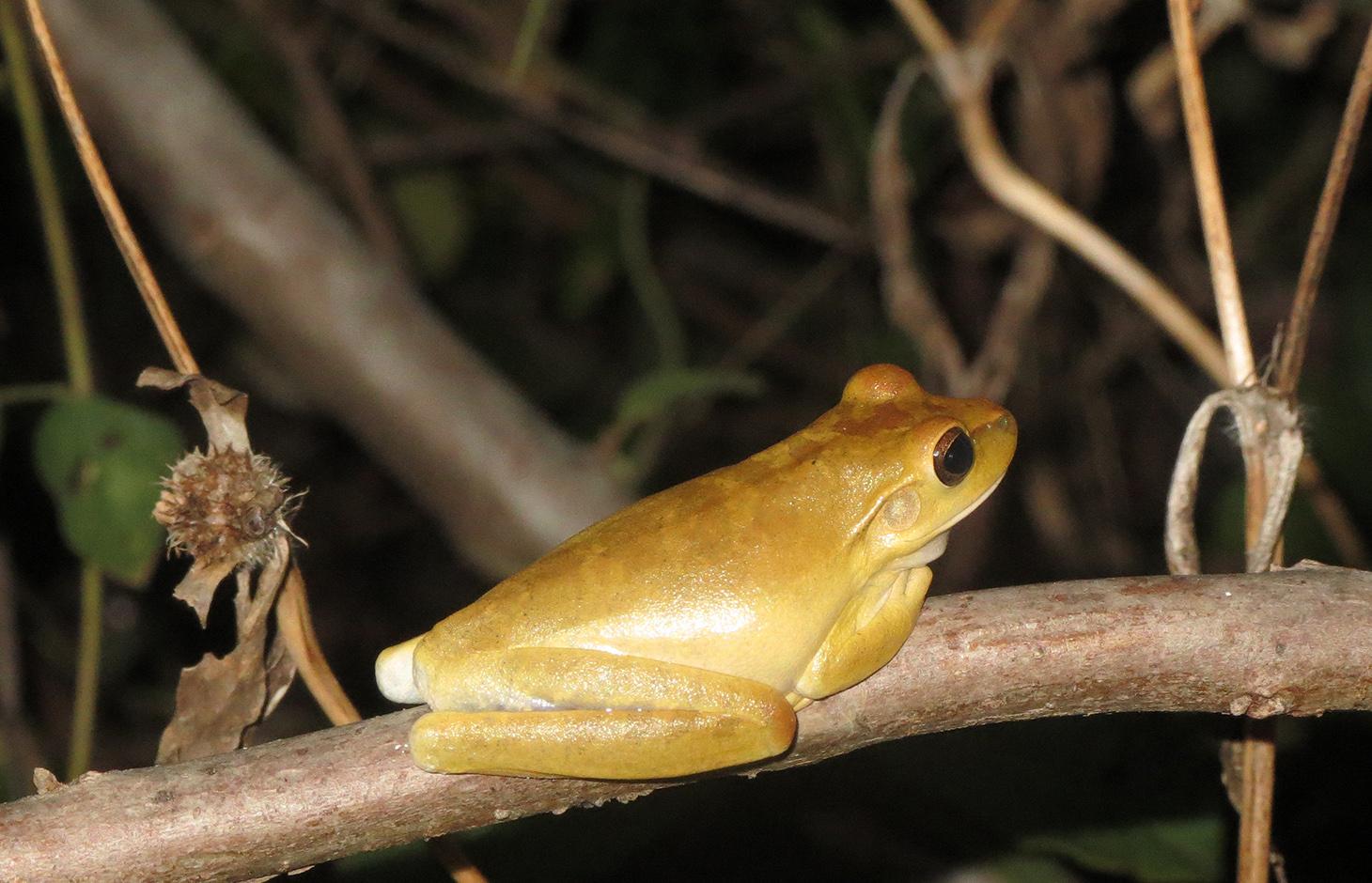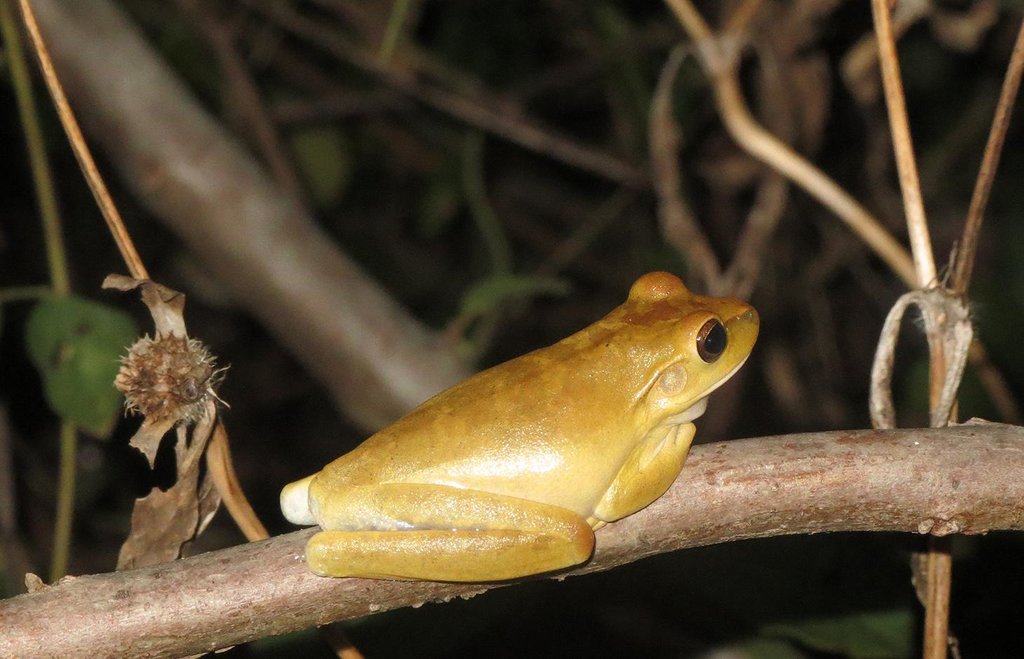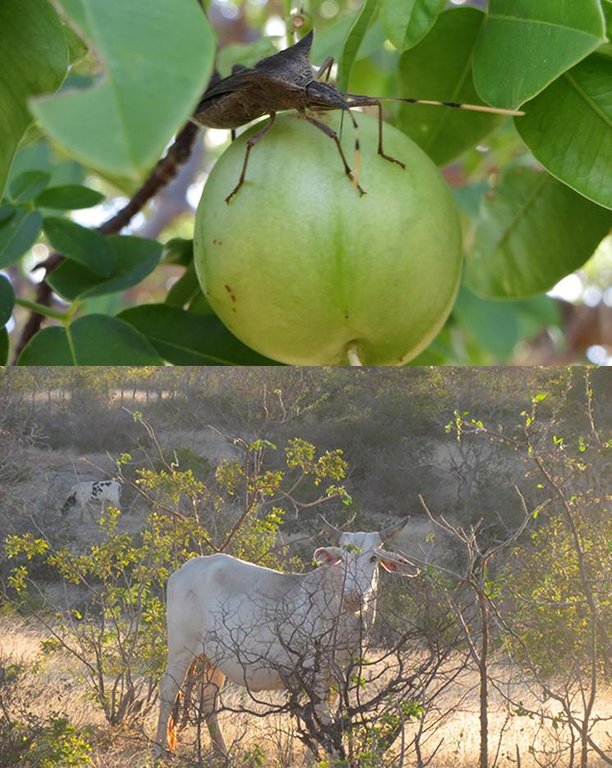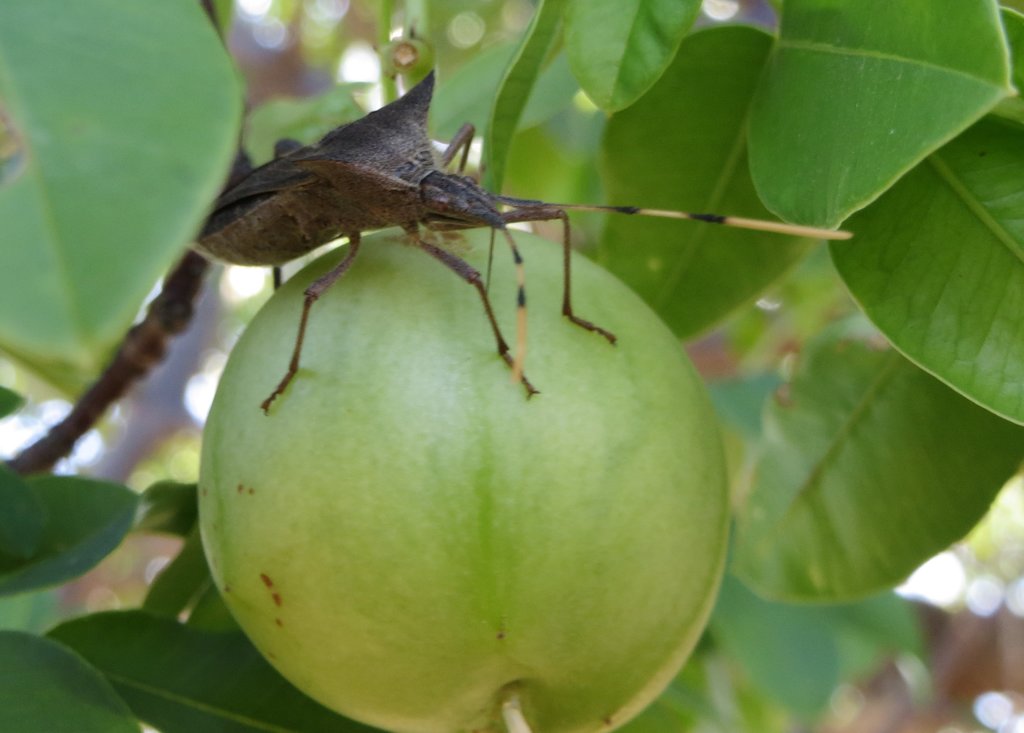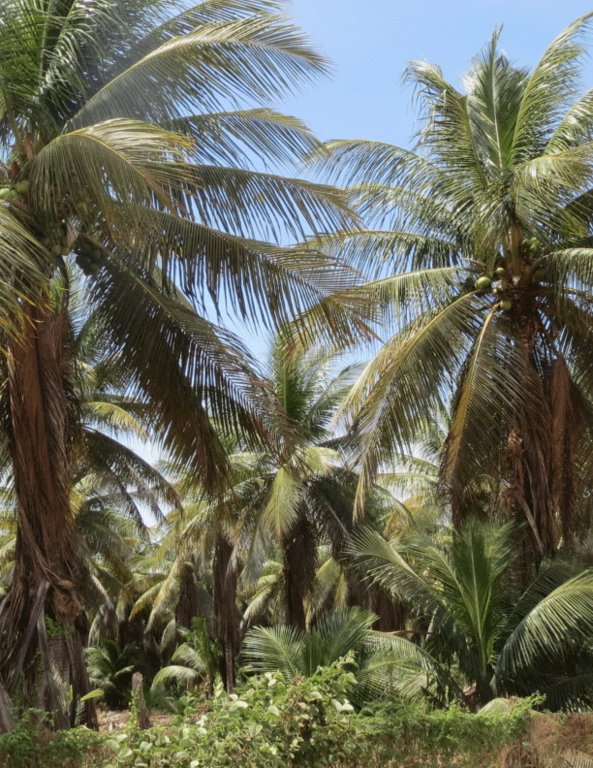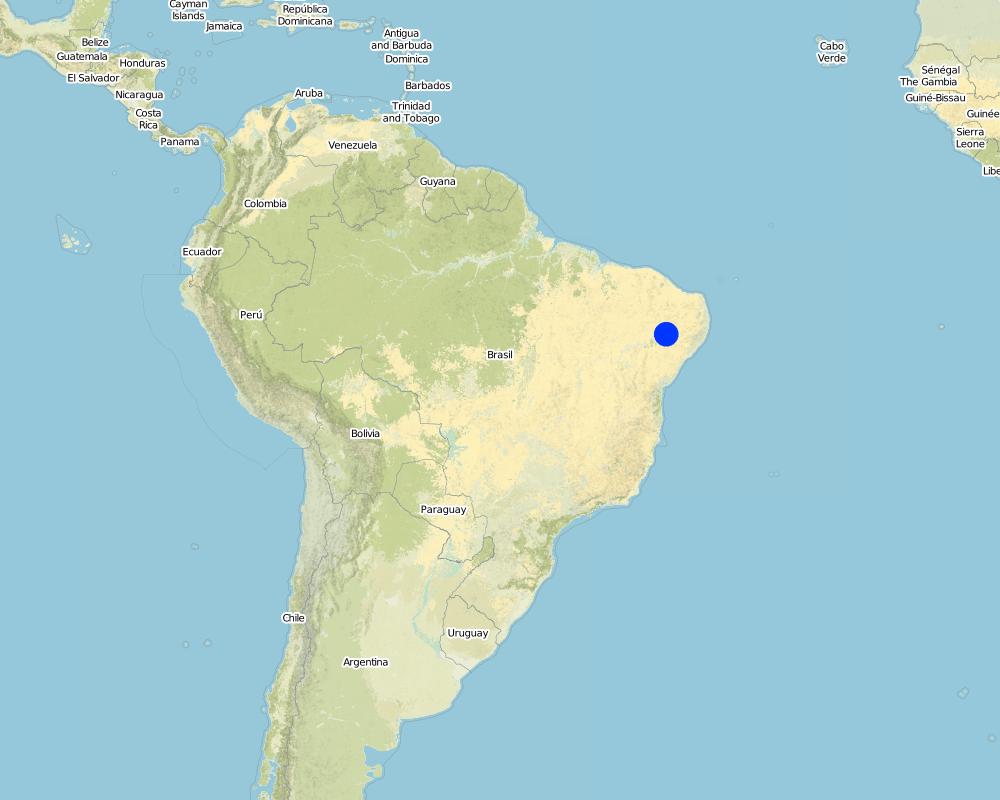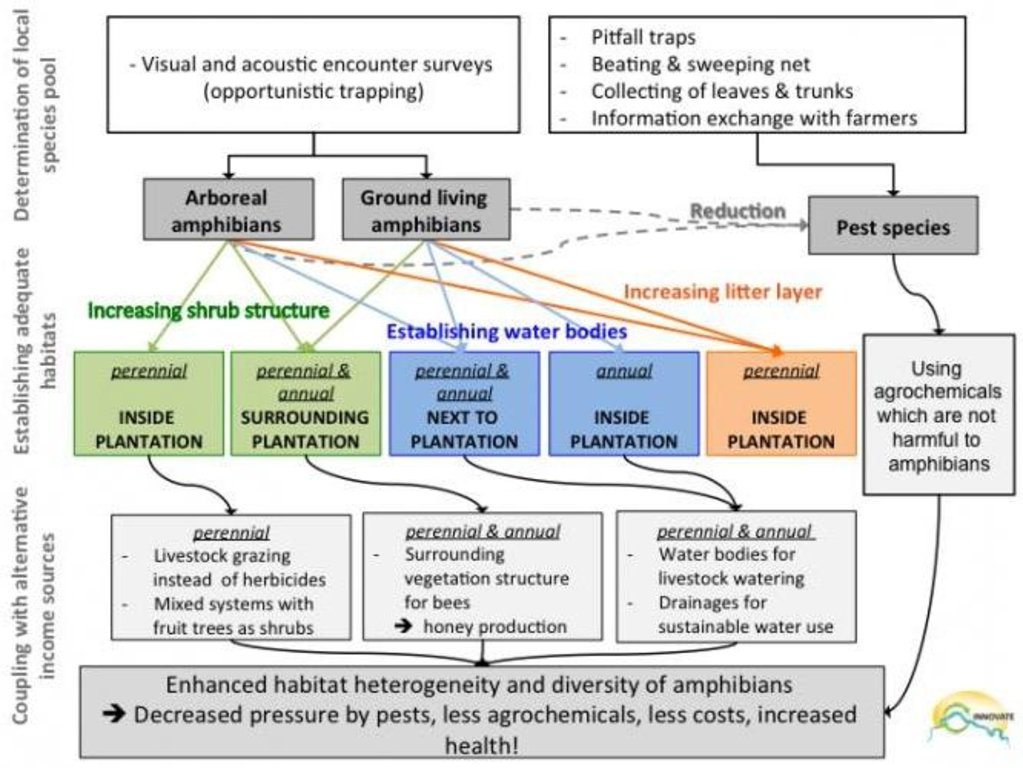Biological pest control through promoting habitats for native fauna [Brasil]
- Creación:
- Actualización:
- Compilador: Marianna Siegmund-Schultze
- Editor: –
- Revisores: Fabian Ottiger, Alexandra Gavilano
Controle biológico de pragas pela fauna nativa: manter ou restabelecer habitats respectivos (Portuguese)
technologies_1293 - Brasil
Visualizar secciones
Expandir todo Colapsar todos1. Información general
1.2 Detalles de contacto de las personas de referencia e instituciones involucradas en la evaluación y la documentación de la Tecnología
Especialista MST:
Biologist:
Ernst Raffale
Senckenberg Natural History Collections Dresden
Koenigsbruecker Landstr. 159, 01109 Dresden, Germany
Alemania
Especialista MST:
Hagel Heinrich
heinrich.hagel@uni-hohenheim.de
Universit of Hohenheim
Wollgrasweg 43, D-70599 Stuttgart, Germany
Alemania
Nombre del proyecto que financió la documentación/ evaluación de la Tecnología (si fuera relevante)
Book project: Making sense of research for sustainable land management (GLUES)Nombre de la(s) institución(es) que facilitaron la documentación/ evaluación de la Tecnología (si fuera relevante)
Universität Hohenheim - AlemaniaNombre de la(s) institución(es) que facilitaron la documentación/ evaluación de la Tecnología (si fuera relevante)
Senckenberg Natural History Collections Dresden - AlemaniaNombre de la(s) institución(es) que facilitaron la documentación/ evaluación de la Tecnología (si fuera relevante)
Technische Universität Berlin (Technische Universität Berlin) - AlemaniaNombre de la(s) institución(es) que facilitaron la documentación/ evaluación de la Tecnología (si fuera relevante)
Leibniz-Institut für Gewässerökologie und Binnenfischerei (IGB) - AlemaniaNombre de la(s) institución(es) que facilitaron la documentación/ evaluación de la Tecnología (si fuera relevante)
Potsdam-Institut für Klimaforschung (PIK) - Alemania1.3 Condiciones referidas al uso de datos documentados mediante WOCAT
¿Cuándo se compilaron los datos (en el campo)?
01/01/2014
El compilador y la/s persona(s) de referencia claves aceptan las condiciones acerca del uso de los datos documentados mediante WOCAT:
Sí
2. Descripción de la Tecnología MST
2.1 Breve descripción de la Tecnología
Definición de la Tecnología:
Reducing the use of common agrochemicals by supporting preferred habitats of biological pest control agents like amphibians and by using alternative self-made organic pesticides.
2.2 Descripción detallada de la Tecnología
Descripción:
Irrigated crops attract various pest species. Farmers usually address crop pest and disease problems through the use of agrochemicals. Especially bees, birds, and amphibians, which fulfil important functions in agroecosystems, are affected by high use of agrochemicals. The combination of inappropriate irrigation practices, incorrect application rates of agrochemicals, and low producer prices often lead, however, to poor income from smallholder irrigated agriculture and to further problems such as poor health, loss of biodiversity, and soil and water contamination. Amphibians are themselves proven biological pest control agents of arthropod pest species (predators of e.g. larvae of butterflies, beetles, termites, bugs and others) and the incorrect use of agrochemicals, as well as the removal of vegetation along field margins hampers this useful function. The technology described here aims to support and utilise the potential of amphibians (such as frogs and toads) as biocontrol agents –as an alternative to agrochemicals in crops.
Purpose of the Technology: Establishing habitats for amphibians is crucial in order to increase and secure their numbers: for example encouraging shrubby vegetation next to water bodies for arboreal frogs, and installing additional water ponds inside and around plantations for ground-living frogs. First, the local species pool of amphibians needs to be determined by visual and acoustic observations. Amphibian species do not need to be determined precisely, but it is important to detect whether they are arboreal and/or ground-living amphibians, as these two groups have different roles as biocontrol agents. Pests that feed on the main cultivated species should be characterized by (a) collecting plant material to determine the type and quantity of pests and (b) by comparing observations with neighbouring farmers and extension agents. Pest species can be determined also by installing traps and using nets. Inspection should be done at least every 15 days to once a month during the whole rainy season to detect possible mass reproduction of arthropods after rainfall events. Once amphibians and pest species are detected, decisions on management strategies can be made. Such a strategy is to create habitats for amphibians with additional sources of income, e.g. by planting pomegranate or guavas as shrubby vegetation structure for arboreal frogs. If pest species can't be reduced solely by amphibian species, the use of agrochemicals has to be reconsidered. Preference shall be given to chemicals which do not harm amphibians. Organic, self-made pesticides based on the extract of manioc roots (manipoera) seem promising. Twenty litres of manipoera, the bark of manicoba tree (Manihot pseudoglaziovii), a cup of American wormseed (Dysphania ambrosioides), a cup of yellow tagetes (Tagetes sp.), a cup of malagueta pepper (Capsicum sp.), garlic and a little bit of bleach have to be chopped, mixed and fermented for 10 days. Application of the final product (25 ml of organic pesticide diluted in 20 l of water) should be done every 8 to 15 days depending on crop species.
Natural / human environment: Increasing habitat heterogeneity stimulates the diversity of amphibians and so a greater number of pest types will be controlled. Combined control by safeguarding natural amphibian habitats and application of organic pesticides is an innovative alternative to the overuse of toxic agrochemicals.
2.3 Fotografías de la Tecnología
2.5 País/ región/ lugares donde la Tecnología fue aplicada y que se hallan comprendidos por esta evaluación
País:
Brasil
Región/ Estado/ Provincia:
Floresta, Itacuruba, Petrolandia
Especifique más el lugar :
Brazil, Pernambuco
Map
×2.6 Fecha de la implementación
Si no se conoce el año preciso, indique la fecha aproximada:
- hace más de 50 años atrás (tradicional)
2.7 Introducción de la Tecnología
Especifique cómo se introdujo la Tecnología:
- durante experimentos/ investigación
3. Clasificación de la Tecnología MST
3.2 Tipo(s) actuales de uso de la tierra donde se aplica la Tecnología

Tierras cultivadas
- Cosecha anual
- Cultivos perennes (no leñosos)
- Cosecha de árboles y arbustos
Cosechas principales (comerciales y de subsistencia):
Major cash crop annual cropping: Watermelone, onion, beans, parsley, tomato, manioc
Major food crop annual cropping: Watermelone, onion, beans, parsley, tomato, manioc
Major cash crop perennial cropping: passion fruit, grape
Major food crop perennial cropping: passion fruit, grape
Major cash crop tree/shrub cropping: mango, coconut, pomegranat, guava, banana
Major food crop tree/shrub cropping: mango, coconut, pomegranat, guava, banana

Cultivos asociados (cultivos/ pastoreo/ árboles), incl. agroforestería
- Agro-silvopastoralismo
Principales productos/ servicios:
Main species: Goat and sheep
Types of forest: Selective felling of (semi-) natural forests, clear felling of (semi-) natural forests, plantation forestry and shifting cultivation.
Comentarios:
Major land use problems (compiler’s opinion): Intensive livestock grazing pressure, agriculture and logging of native vegetation are the driving factors behind loss of the Caatinga dry forest. The high use of agrochemicals additionally pollutes soils and watersheds, and probably also decreases local biodiversity. Droughts seem to occur more frequently and these decrease water and food availability for livestock, as well as affecting the local fauna.
Example for establishment of technology within study region: In the irrigation schemes of Petrolândia, Pernambuco, Brazil, the most important arthropod pest species in banana plantation was a weevil (Curculionidae, Coleoptera). The weevil (so called “moleque da bananeira”) attacked the roots of the banana plants, in consequence the plant tumbled down and was lost. As the weevil stays during the day in the ground and only starts moving during the night, it is difficult to combat this pest species by agrochemicals. With an increase of small water ponds with a shore vegetation structure (for example at 2 corners of the plantation) the abundance of ground-living amphibians increases and so the presence of amphibians in the banana plantation which feed on the weevil during the night.
Major land use problems (land users’ perception): Droughts and consequently problems of feeding livestock on natural vegetation (lack of fodder and grazing grounds), deforestation, extensive and inappropriate use of agrochemicals, low producer prices.
Nomadism: goat, sheep, cattle
Semi-nomadism / pastoralism: goat, sheep, cattle
Ranching: goat, sheep, cattle
Cut-and-carry/ zero grazing: goat, sheep, cattle
Improved pasture: goat, sheep, cattle
Mixed: (eg agro-pastoralism, silvo-pastoralism): goat, sheep, cattle
Selective felling of (semi-) natural forests: Yes
Clear felling of (semi-)natural forests: Yes
Shifting cultivation: Yes
Plantation forestry: Yes
Forest products and services: timber, fuelwood, fruits and nuts, grazing / browsing, other forest products / uses (honey, medical, etc.), nature conservation / protection
Livestock is grazing on crop residues
3.3 Información adicional sobre el uso de tierras
Número de temporadas de cultivo por año:
- 1
Especifique:
Longest growing period from month to month: January to May
3.4 Grupo MST al que pertenece la Tecnología
- manejo integrado de pestes y enfermedades (incl. agricultura orgánica)
- Biological pest control
3.5 Difusión de la Tecnología
Especifique la difusión de la Tecnología:
- distribuida parejamente sobre un área
Si la tecnología se halla difundida homogéneamente en un área, indique el área aproximada que cubre:
- 0.1-1 km2
Comentarios:
The technology was carried out both in a forest system as well as in agricultural areas. An incrasing SLM Technology area is linked to an increasing sampling number.
3.6 Medidas MST que componen la Tecnología

medidas agronómicas
- A1: vegetación/ cubierta del suelo

medidas vegetativas
- V1: Cubierta de árboles y arbustos
- V2: Pastos y plantas herbáceas perennes

medidas estructurales
- S3: Acequias graduadas, canales, vías fluviales
- S5: Diques, hondonadas, estanques

medidas de manejo
- M2: Cambio de gestión/ nivel de intensidad
Comentarios:
Main measures: agronomic measures, vegetative measures, structural measures, management measures
Type of agronomic measures: retaining more vegetation cover
3.7 Principales tipos de degradación de la tierra encarados con la Tecnología

deterioro químico del suelo
- Cn: reducción de la fertilidad y contenido reducido de la materia orgánica del suelo (no ocasionados por la erosión)

degradación biológica
- Bc: reducción de la cobertura vegetal del suelo
- Bh: pérdida de hábitats
- Bs: reducción en la calidad y composición/ diversidad de las especies
- Bp: incremento de pestes/ enfermedades, pérdida de depredadores

degradación del agua
- Hs: cambio en la cantidad de aguas superficiales
Comentarios:
Main type of degradation addressed: Bc: reduction of vegetation cover, Bh: loss of habitats, Bs: quality and species composition /diversity decline, Bp: increase of pests / diseases, loss of predators, Hs: change in quantity of surface water
Secondary types of degradation addressed: Cn: fertility decline and reduced organic matter content
Main causes of degradation: crop management (annual, perennial, tree/shrub) (high use of agrochemicals, degradation of natural habitats), deforestation / removal of natural vegetation (incl. forest fires) (high logging and grazing intensity, no forest area without grazing!), overgrazing (high logging and grazing intensity, no forest area without grazing!), change in temperature (droughts become more frequently), change of seasonal rainfall (droughts become more frequently), Heavy / extreme rainfall (intensity/amounts) (less rainfall intensity), droughts (droughts become more frequently)
Secondary causes of degradation: urbanisation and infrastructure development (extending farmlands), population pressure (extending farmlands), poverty / wealth (farmers need to use natural resources as livestock fodder), education, access to knowledge and support services (less environmental awareness)
3.8 Prevención, reducción o restauración de la degradación de la tierra
Comentarios:
Main goals: prevention of land degradation, mitigation / reduction of land degradation
Secondary goals: rehabilitation / reclamation of denuded land
4. Especificaciones técnicas, actividades de implementación, insumos y costos
4.1 Dibujo técnico de la Tecnología
4.2 Especificaciones técnicas/ explicaciones del dibujo técnico
Vegetation structures surrounding plantations beside waterbodies guarantee the occurrence of arboreal and ground-living amphibians. Arboreal frogs prefer shrubby vegetation. Since mowing or application of herbicides often eliminates shrubs, moderate livestock grazing might be a better option. The additional water bodies outside the plantation can thereby be used for livestock watering, as long as the surrounding vegetation structure is not eliminated through grazing. Fruit trees such as Guava or Pomegranate as shrub structure provide an additional source of income. To ensure the presence of ground-living frogs, smaller water bodies must be promoted within the plantation. Here puddles from leaky irrigation systems seem to be sufficient already.
Only agrochemicals and organic pesticides that are harmless to amphibians should be used as additional chemical pest control.
Date: 2016
Technical knowledge required for field staff / advisors: moderate (kowledge of habitat preference of important species and management issues)
Technical knowledge required for land users: low (kowledge of habitat preference of important species and management issues)
Main technical functions: increase in nutrient availability (supply, recycling,…), increase of biomass (quantity), promotion of vegetation species and varieties (quality, eg palatable fodder)
Secondary technical functions: control of dispersed runoff: retain / trap, control of dispersed runoff: impede / retard, control of concentrated runoff: retain / trap, control of concentrated runoff: impede / retard, control of concentrated runoff: drain / divert, increase of surface roughness, improvement of surface structure (crusting, sealing), improvement of topsoil structure (compaction), stabilisation of soil (eg by tree roots against land slides), increase in organic matter
Retaining more vegetation cover
Material/ species: herbs in planation of coconut, banana, guave, pomegranat etc.
Quantity/ density: dense
Change of land use practices / intensity level: less grazing in forest areas, less grazing at water ponds (fencing of a certain part of the pond), less cutting of shrubs and herbs in crop plantations (near to natural cutting by livestock)
4.4 Actividades de establecimiento
| Actividad | Tipo de medida | Momento | |
|---|---|---|---|
| 1. | Installing of additional small and large water bodies: a. large ponds outside the plantation (~100 m²/pond, ~ 4 ponds/plantation, one working day per pond) b. smaller ponds for ground-living frogs inside the plantation (one working day/ 5 ha). c. drainages can be installed instead of ponds outside the plantation for sustainable water use (machine rent) | Estructurales | |
| 2. | Planting shrubby vegetation or fruit trees outside and inside the plantation. Planting of Guava trees as shrubby vegetation: 25% density compared to Guava monoculture (e.g. 1.25 working days for exclusive Guava plantation) | Estructurales | |
| 3. | As irrigation was free in the study region, there were no costs calculated | Estructurales | |
| 4. | Knapsack sprayer for application of pesticides | Estructurales |
4.5 Costos e insumos necesarios para el establecimiento
| Especifique insumo | Unidad | Cantidad | Costos por unidad | Costos totales por insumo | % de los costos cubiertos por los usuarios de las tierras | |
|---|---|---|---|---|---|---|
| Mano de obra | Labour | ha | 1,0 | 49,05 | 49,05 | 100,0 |
| Equipo | Machine rent | ha | 1,0 | 100,0 | 100,0 | 100,0 |
| Equipo | Knapsack sprayer | ha | 1,0 | 90,0 | 90,0 | 100,0 |
| Material para plantas | Seedlings | ha | 1,0 | 75,0 | 75,0 | 100,0 |
| Costos totales para establecer la Tecnología | 314,05 | |||||
4.6 Actividades de establecimiento/ recurrentes
| Actividad | Tipo de medida | Momento/ frequencia | |
|---|---|---|---|
| 1. | Monitoring amphibian species at least 3 nights in the rainy season (can be done by the farmer himself) | Estructurales | |
| 2. | Monitoring of pest species (1 hour/ha) at least every 15 days in the rainy season (5 month/year) and once a month in dry season (7 month/year) (can be done by the farmer himself) | Estructurales | |
| 3. | Production and application of organic pesticides (25 ml of organic pesticide diluted in 20 l of water and applied every 8 to 15 days). Note: for commercial pesticides the application costs are the same. | Estructurales | |
| 4. | Application of fertilizer (1 working day/ year) | Estructurales | |
| 5. | Pruning of trees (5.25 working days(/year) | Estructurales |
4.7 Costos e insumos necesarios para actividades de mantenimiento/ recurrentes (por año)
| Especifique insumo | Unidad | Cantidad | Costos por unidad | Costos totales por insumo | % de los costos cubiertos por los usuarios de las tierras | |
|---|---|---|---|---|---|---|
| Mano de obra | Labour | ha | 1,0 | 821,75 | 821,75 | 100,0 |
| Indique los costos totales para mantenecer la Tecnología | 821,75 | |||||
Comentarios:
To calculate the above example a scenario with maximum activities was taken. Any other scenario will be cheaper. Prices are from the year 2013. Real 1 = USD 0.3.. A total of 6 liters of concentrated organic pesticides per hectare per year are needed. This applies for both self-made and commercial pesticides. As commercial organic pesticides cost about USD 36 per liter, farmers spend USD 216 less per year for self-produced organic pesticides. Similarly commercial non-organic pesticides are more expensive compared to self-made organic pesticides. An additional income of USD 120 / ha / harvest were estimated for guava trees even under possible poor conditions like shadow and extensive management. Other additional sources of income are from the sale of self-produced organic pesticides and livestock grazing instead of using herbicides.
5. Entorno natural y humano
5.1 Clima
Lluvia anual
- < 250 mm
- 251-500 mm
- 501-750 mm
- 751-1,000 mm
- 1,001-1,500 mm
- 1,501-2,000 mm
- 2,001-3,000 mm
- 3,001-4,000 mm
- > 4,000 mm
Especificaciones/ comentarios sobre la cantidad de lluvia:
8 month of drought , 4 months of rain
Zona agroclimática
- semi-árida
Thermal climate class: tropics
5.2 Topografía
Pendientes en promedio:
- plana (0-2 %)
- ligera (3-5%)
- moderada (6-10%)
- ondulada (11-15%)
- accidentada (16-30%)
- empinada (31-60%)
- muy empinada (>60%)
Formaciones telúricas:
- meseta/ planicies
- cordilleras
- laderas montañosas
- laderas de cerro
- pies de monte
- fondo del valle
Zona altitudinal:
- 0-100 m s.n.m.
- 101-500 m s.n.m.
- 501-1,000 m s.n.m
- 1,001-1,500 m s.n.m
- 1,501-2,000 m s.n.m
- 2,001-2,500 m s.n.m
- 2,501-3,000 m s.n.m
- 3,001-4,000 m s.n.m
- > 4,000 m s.n.m
Comentarios y especificaciones adicionales sobre topografía :
Slopes on average: gentle (3-5%), moderate (6-10%), rolling (11-15%), hilly (16-30%)
5.3 Suelos
Profundidad promedio del suelo:
- muy superficial (0-20 cm)
- superficial (21-50 cm)
- moderadamente profunda (51-80 cm)
- profunda (81-120 cm)
- muy profunda (>120 cm)
Textura del suelo (capa arable):
- áspera/ ligera (arenosa)
Materia orgánica de capa arable:
- media (1-3%)
- baja (<1%)
Si se halla disponible, adjunte una descripción completa de los suelos o especifique la información disponible, por ej., tipo de suelo, pH/ acidez de suelo, capacidad de intercambio catiónico, nitrógeno, salinidad, etc. :
Soil fertility is: Very low-low
Soil drainage/infiltration is: Poor-medium
Soil water storage capacity: Very low-low
5.4 Disponibilidad y calidad de agua
Agua subterránea:
> 50 m
Disponibilidad de aguas superficiales:
pobre/ ninguna
Calidad de agua (sin tratar):
agua potable de mala calidad (requiere tratamiento)
5.5 Biodiversidad
Comentarios y especificaciones adicionales sobre biodiversidad:
Species diversity: medium, low
Species richness of the study region depended strongly on habitat heterogeneity.
5.6 Las características de los usuarios de la tierra que aplican la Tecnología
Ingresos no agrarios:
- 10-50% de todo el ingreso
Nivel relativo de riqueza:
- promedio
Individuos o grupos:
- individual/ doméstico
Nivel de mecanización:
- trabajo manual
- tracción animal
Género:
- mujeres
- hombres
Indique otras características relevantes de los usuarios de las tierras:
Land users applying the Technology are mainly common / average land users
Population density: 10-50 persons/km2
Annual population growth: 1% - 2%
Off-farm income specification: the same, there are just single farmers who use the technology till now
Market orientation of production system: subsistence (self-supply), subsistence (self-supply), subsistence (self-supply), mixed (subsistence/ commercial, mixed (subsistence/ commercial, commercial/ market, commercial/ market
5.7 Área promedio de la tierra que pertenece a o es arrendada por usuarios de tierra que aplican la Tecnología
- < 0.5 ha
- 0.5-1 ha
- 1-2 ha
- 2-5 ha
- 5-15 ha
- 15-50 ha
- 50-100 ha
- 100-500 ha
- 500-1,000 ha
- 1,000-10,000 ha
- > 10,000 ha
¿Esto se considera de pequeña, mediana o gran escala (refiriéndose al contexto local)?
- escala mediana
Comentarios:
Average area of land owned or leased by land users applying the Technology: < 0.5 ha, 0.5-1 ha, 1-2 ha, 2-5 ha
5.8 Tenencia de tierra, uso de tierra y derechos de uso de agua
Tenencia de tierra:
- estado
Derechos de uso de tierra:
- individual
- official registration and permission
- official registration and permission
5.9 Acceso a servicios e infraestructura
salud:
- pobre
- moderado
- bueno
educación:
- pobre
- moderado
- bueno
asistencia técnica:
- pobre
- moderado
- bueno
empleo (ej. fuera de la granja):
- pobre
- moderado
- bueno
mercados:
- pobre
- moderado
- bueno
energía:
- pobre
- moderado
- bueno
caminos y transporte:
- pobre
- moderado
- bueno
agua potable y saneamiento:
- pobre
- moderado
- bueno
servicios financieros:
- pobre
- moderado
- bueno
6. Impactos y comentarios para concluir
6.1 Impactos in situ demostrados por la Tecnología
Impactos socioeconómicos
Producción
producción de cultivo
producción de forraje
producción animal
área de producción
Ingreso y costos
gastos en insumos agrícolas
diversidad de fuentes de ingreso
Impactos socioculturales
situación de salud
Comentarios/ especifique:
Reduced pesticide toxic effect on human health
Improved livelihoods and human well-being
Comentarios/ especifique:
Less use of agrochemicals
Impactos ecológicos
Biodiversidad: vegetación, animales
diversidad vegetal
diversidad animal
diversidad de hábitats
control de pestes/ enfermedades
6.2 Impactos fuera del sitio demostrados por la Tecnología
inundaciones río abajo
6.3 Exposición y sensibilidad de la Tecnología al cambio climático gradual y a extremos relacionados al clima/ desastres (desde la percepción de los usuarios de tierras)
Cambio climático gradual
Cambio climático gradual
| Estación | tipo de cambios climáticos/ climas extremos | ¿Cómo es que la tecnología soporta esto? | |
|---|---|---|---|
| temperatura anual | incrementó | bien |
Extremos (desastres) relacionados al clima
Desastres climatológicos:
| ¿Cómo es que la tecnología soporta esto? | |
|---|---|
| tormenta de lluvia local | no muy bien |
| tormenta de viento | bien |
Desastres climatológicos
| ¿Cómo es que la tecnología soporta esto? | |
|---|---|
| sequía | no muy bien |
Desastres hidrológicos
| ¿Cómo es que la tecnología soporta esto? | |
|---|---|
| inundación general (río) | bien |
Otras consecuencias relacionadas al clima
Otras consecuencias relacionadas al clima
| ¿Cómo es que la tecnología soporta esto? | |
|---|---|
| periodo reducido de crecimiento | bien |
Comentarios:
As amphibians depend in their abundance and species composition on the rainfall amount and intensity the technology is sensitive for changing rainfall events by increasing abundance of amphibians with higher rainfall amount and so probably a better pest control.
In case of frequent droughts, reptiles like lizards get more important as they do not depend so strong on rainfall events like amphibians.
6.4 Análisis costo-beneficio
¿Cómo se comparan los beneficios con los costos de establecimiento (desde la perspectiva de los usuarios de tierra)?
Ingresos a corto plazo:
negativo
Ingresos a largo plazo:
positivo
¿Cómo se comparan los beneficios con los costos de mantenimiento/ recurrentes (desde la perspectiva de los usuarios de tierra)?
Ingresos a corto plazo:
ligeramente negativo
Ingresos a largo plazo:
positivo
6.5 Adopción de la Tecnología
Comentarios:
There is no trend towards spontaneous adoption of the Technology
Comments on adoption trend: Technology is still in the testing phase and it is too early to give any data on acceptance or adoption
6.7 Fuerzas/ ventajas/ oportunidades de la Tecnología
| Fuerzas/ ventajas/ oportunidades desde la perspectiva del compilador o de otra persona de referencia clave |
|---|
|
A strong advantage is the low cost of this ecosystem service which is provided almost freely to farmers, especially when the potential for pest control (abundancy of useful amphibians) is high enough to eliminate the need for agrochemicals. How can they be sustained / enhanced? Establish adequate habitats to maintain high diversity of the relevant reptiles and amphibians. |
|
Less use of agrochemicals results in a healthier environment for producers and consumers How can they be sustained / enhanced? If the potential of the reptiles and amphibians is not high enough to combat all pest species, organic chemicals or alternative biocontrol species could be used (for example horntails etc.). |
|
Changing monoculture to mixed systems - or even agropastoral systems - offers additional income sources, while diversification often as a buffer to sudden drops in the price of a particular crop How can they be sustained / enhanced? The crop mixture needs to be well designed, to ensure that the harvests of important crops are not affected too much, and the reduction compensated for by the others. |
6.8 Debilidades/ desventajas/ riesgos de la Tecnología y formas de sobreponerse a ellos
| Debilidades/ desventajas/ riesgos desde la perspectiva del compilador o de otra persona de referencia clave | ¿Cómo sobreponerse a ellas? |
|---|---|
| Droughts and limited water availability influence species richness of amphibians. | Providing sufficient water bodies for amphibians to outwear heavy droughts is recommended. |
7. Referencias y vínculos
7.2 Vínculos a las publicaciones disponibles
Título, autor, año, ISBN:
): Guschal & Hagel et al. Benefits of site-adapted management (pest-control) innovations in northeastern Brazil.
¿Dónde se halla disponible? ¿Costo?
In preparation
Vínculos y módulos
Expandir todo Colapsar todosVínculos
No hay vínculos
Módulos
No se hallaron módulos


